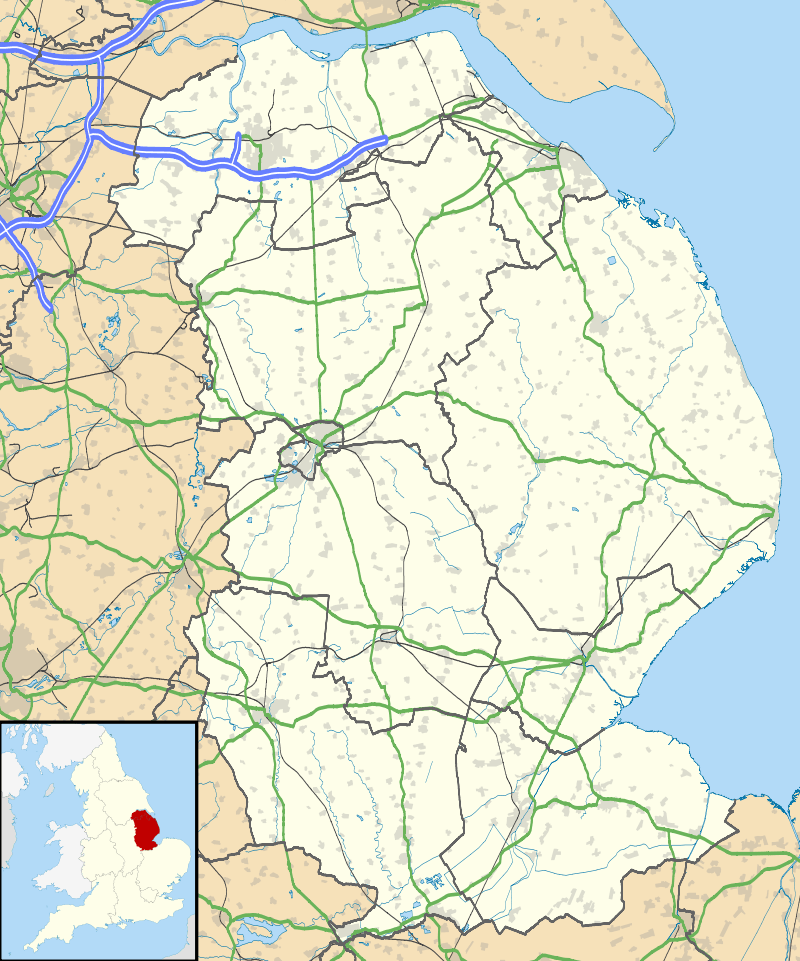Sausthorpe
| Sausthorpe | |
 Church of St Andrew, Sausthorpe |
|
 Sausthorpe |
|
| Population | 305 (Including Aswardby , Dalby and Langton by Spilsby. 2011)[1] |
|---|---|
| OS grid reference | TF383694 |
| – London | 140 mi (230 km) S |
| District | East Lindsey |
| Shire county | Lincolnshire |
| Region | East Midlands |
| Country | England |
| Sovereign state | United Kingdom |
| Post town | Spilsby |
| Postcode district | PE23 |
| Police | Lincolnshire |
| Fire | Lincolnshire |
| Ambulance | East Midlands |
| EU Parliament | East Midlands |
| UK Parliament | Louth and Horncastle |
|
|
Coordinates: 53°12′11″N 0°04′12″E / 53.203°N 0.070°E
Sausthorpe is a small village and civil parish in the East Lindsey district of Lincolnshire, England. It is situated 8 miles (13 km) east from Horncastle and 3 miles (4.8 km) north-west from Spilsby. Sausthorpe is within the Lincolnshire Wolds valley of the River Lymn, and on the southern edge of the Lincolnshire Wolds Area of Outstanding Natural Beauty.
The name is believed to derive from "Sauthr's thorpe", a farming settlement here in Viking times.[2] Farming remains the predominant economic activity of the area.
The parish church is dedicated to St Andrew and is a Grade II listed building. It was designed by Charles Kirk and built in 1842 on the site of an earlier medieval church.[3][4] Its construction was sponsored by Rev. Francis A. Swan, Lord of the Manor and parish rector from 1819 until his death in 1878. The spire is a prominent local landmark, and resembles on a smaller scale the spire of St. James Church, Louth, 12 miles (19 km) to the north. T. Pelham Dale SSC, who was prosecuted and imprisoned for ritualist practices in 1876 and 1880, and thus regarded as a martyr by Anglo-Catholics, was the parish priest from 1881-1892; his grave can be seen under the trees on the eastern side of the churchyard. Inside the church, several Dymoke family gravestones dating from the 18th century can be seen; these were left in place from the earlier church.
In 1885 Kelly's Directory recorded the Rev. Charles Trollope Swan LLB as living at Sausthorpe Hall, a "modern mansion in a park of 30 acres". (He had inherited the roles of Lord of the Manor and rector from his father Francis Swan in 1878.)
Charles Trollope Swan gave the rectorate, including the rectory living, residence (the Old Hall, see below) and 34 acres (0.14 km2) of glebe land, to T. Pelham Dale in 1882.
Rev. Francis A. Swan built a National School for 50 children, in 1860. (The school finally closed in 1983.)
Kelly's Directory also recorded that in 1885 the area of the parish was 727 acres (2.9 km2), in which were grown wheat, barley and turnips, that Sausthorpe's population at the time of the 1881 census was 141, and that within the parish were a grocer, wheelwright, carrier, two farmers, a farmer-cum-beer retailer, and a farmer-surveyor.[5]
Sausthorpe Hall is a late 18th-century Grade II listed country house, extended and remodelled in 1822.[6]
The Old Hall is a Grade II* listed 15th-century house, with 16th- and 18th-century alterations. It consists of render over red brick and the remains of a timber frame.[7]
References
- ↑ "Parish population 2011". Retrieved 20 August 2015.
- ↑ Cameron, Kenneth (1998); A Dictionary of Lincolnshire Place-names, English Place-Name Society. ISBN 0904889580
- ↑ Historic England. "St Andrews, Sausthorpe (1034892)". PastScape. Retrieved 10 August 2011.
- ↑ Historic England. "St Andrews, Sausthorpe (1063638)". National Heritage List for England. Retrieved 10 August 2011.
- ↑ Kelly's Directory of Lincolnshire with the port of Hull 1885, p. 611
- ↑ Historic England. "Sausthorpe Hall (1063637)". National Heritage List for England. Retrieved 10 August 2011.
- ↑ Historic England. "The Old Hall, Sausthorpe (1063639)". National Heritage List for England. Retrieved 10 August 2011.
External links
 Media related to Sausthorpe at Wikimedia Commons
Media related to Sausthorpe at Wikimedia Commons